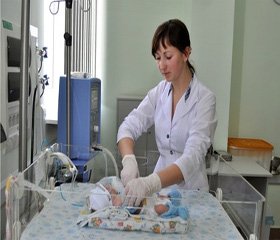Журнал «Здоровье ребенка» 1 (52) 2014
Вернуться к номеру
Intracranial birth trauma of newborns
Авторы: Shevtsova T.I. - National Medical University named after O.O. Bogomolets, Ukraine
Рубрики: Педиатрия/Неонатология
Разделы: Справочник специалиста
Версия для печати
The problem of intracranial birth trauma (IBT) of newborns attracts the attention of pediatricians, obstetricians, neurologists and neurosurgeons.
Despite significant advances in the field of obstetrics, the incidence remains high, 1,8–3 % of all births. Cases of IBT account for 10–20 % of all cases of birth injuries of the nervous system. In the structure of perinatal mortality, IBT accounts for 10–12 %. Relevance of studying this problem is determined not only by the high mortality of newborns, but also by considerable frequency and severity of residual effects of IBT. Among all the diseases of nervous system of the children 75 % are related to IBT.
IBT includes intracranial hemorrhage (ICH) in the brain matter, its membranes, and other intracranial structural changes of the nervous system caused during delivery.
The head of the fetus and the newborn has some principled anatomical and physiological differences from the adult`s head. The head circumference is the largest part of the body of newborn. In most cases, head carries the formation of the birth canal and takes the maximum load. Ability to deform the newborn's head during childbirth caused by the presence of two features: flexibility and elasticity. Elasticity of the skull is caused by the presence of the fontanelles and sutures, that provide the mobility of skull bones during delivery and cause a decrease of the head circumference while passing the birth canal. The large crescent-shaped appendage of the dura mater and the gallop of the cerebellum provide flexibility of newborn`s skull and prevent excessive deformation of the head during labor.
There are three groups of factors that predispose to abnormal compression of the head during the labor: the fetus (prematurity, postmaturity, large head size), features of the birth canal (narrow pelvis, rigidity of the birth canal, discrepancy between the size of the fetus and the mother's pelvis) and the dynamics of labor (rapid, prolonged labor, obstetric care, etc.).
Pathomorphological changes in acute period of IBT are presened by the brain plethora, venous stasis, capillary stasis in the brain matter and the brain membranes, hemorrhages, degenerative changes in the cells of the cortex and subcortical structures, perivascular and pericellular edema. Intrauterine hypoxia is often preceded or accompanied by IBT.
Traumatic and nontraumatic ratio of ICH for newborns is 1 : 10. Epidural, subdural hematoma, bleeding in the cerebellum usually have a traumatic genesis. Other ICH (subarachnoid, parenchymal, intraventricular) can have traumatic and hypoxic genesis. Confirmation of the reason of damage is carried out on the basis of history, clinical manifestations, as well as the simultaneous detection of birth trauma in other localizations (damage to the skull bones, cephalohematoma, etc.), laboratory data and radiological studies.
Clinical manifestations include behavioral changes of newborn (excitation, depression, drowsiness, coma), symptoms associated with blood loss (pallor, jaundice, hypotension, shock, disseminated intravascular coagulation), signs of increased intracranial pressure (bulging of large fontanelle, dilatation of cranial sutures, throw back of head, regurgitation, vomiting), signs of brain compression (apnea, asphyxia, bradycardia, unstable body temperature, unstable blood pressure), symptoms of cranial nerves damage (nystagmus, ptosis, anisocoria, pseudobulbar disorders).
Various types of paresis, changes of muscle tone and changes of reflexes can also be an expression of the ICH. The clinical course of ICH can be gradual, catastrophic and asymptomatic.
IBT has to be differentiated from:
- Malformations of the brain;
- Intrauterine infections (meningitis, encephalitis);
- Hypoxic-ischemic encephalopathy;
- Transient and hereditary metabolic disorders.
Laboratory-instrumental studies and consultations with specialists in case of IBT:
- Clotting time, coagulation;
- Changes of hemoglobin, hematocrit, blood glucose, bilirubin;
- Neuroimaging: neurosonography, computer tomography, magnetic resonance therapy;
- Neurophysiological studies;
- X-ray of the skull (if indicated);
- Ocular fundus examination;
- Study of the cerebrospinal fluid;
- Consultation: neurologist , ophthalmologist, neurosurgeon, physiotherapist.
IBT treatment includes adequate oxygenation; maintaining of adequate hemodynamics, maintaining of blood glucose, maintaining of fluid, electrolyte balance and acid-base status, treatment of seizures; hemostatic therapy, control of coagulation and hematocrit, control of injected and excreted liquid; constant cardio - respiratory monitoring, surgery to remove the hematoma and decompression.
IBT outcome. The severity of damage determines the prognosis for life and further static- motor and neuropsychological development of the child.
The consequences are come out in seizures, spastic paresis, ataxia, hyperkinesis, subcortical blindness, intellectual deficit. At the stage of recovery these children have some threatening signs:
- Anomaly tone (expressed flexor tone in the hands coupled with increased extensor tone in the legs);
- Abnormal position of the toes (spontaneous Babinski, lack of plantar flexion);
- Abnormal position of the fingers (adduction of the thumb and index finger flexion);
- Preservation and lack of reduction of congenital reflexes.
IBT prophylaxis includes the selection of optimal obstetric tactic. This tsctic includes a risk assessment of the pregnant woman before delivery; selection of an appropriate method of delivery; monitoring the mother and the fetus during delivery; labor pain relief; careful management of labor, especially in assisting of obstetrician ("protection of the perineum", flexion and excretion of the fetal head, etc.); improvement of the technique and skills of forceps’ application, using of vacuum-extractor; managing laboring in the breech presentation, correct care of the newborn with suspected birth trauma.

